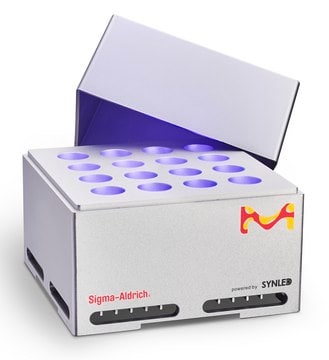Z744035
Fotorreactor Penn PhD M2
Sinónimos:
photoreactor
About This Item
Productos recomendados
AC/DC input
100 - 240 V AC, 50/60 Hz
feature
thermocouple type K-Type Thermocouple
(Touch Screen: 3.5” TFT LCD; 320 x 480 resolution)
reaction suitability
reaction type: Photocatalysis
reagent type: catalyst
parameter
(Variable stir bar control 100 - 2000 RPM)
0-95% RH at 10-40 °C
W × H × D
11.4 cm × 27.2 cm × 27.9 cm
4.5 in. × 10.7 in. × 11.0 in.
shipped in
ambient
Categorías relacionadas
General description
Características y beneficios
- El diseño modular permite su uso con una variedad de longitudes de onda: 450 nm (incluido), 420 nm (se vende por separado), 395 nm (se vende porseparado) y 365 nm (se vende por separado)
- El entorno reflectante de 360 grados maximiza la captura de fotones en el área superficial
- El bloqueo del escudo de luz evita la exposición del usuario a rayos de luz dañinos
- La pantalla táctil interactiva controla los parámetros de reacción
- Aprobado por Intertek ETL, CE y CB
- Parámetros definidos por el usuario: temperatura, intensidad de luz, velocidad del ventilador y agitación
- Opciones de parada automática, pausa y reinicio
- Admite tamaños de viales gc, 4, 8, 20, 40 ml
- Se dispone de soportes para viales múltiples que permiten la ejecución en paralelo de cuatro viales de 8 ml y cinco viales de 4 ml reacciones.
- Control de la temperatura mediante un termopar tipo K.
- Z744035-1EA-US: tipo B
- Z744035-1EA- IN: tipo D
- Z744035-1EA-EU-E: tipo E
- Z744035-1EA-EU-F: tipo F
- Z744035-1EA- UK: tipo G
- Z744035-1EA- CN: tipo I
- Z744035-1EA- CH: Tipo J
Tecnología de fotocatálisis Spotlight
related product
Choose from one of the most recent versions:
Certificados de análisis (COA)
Sorry, we don't have COAs for this product available online at this time.
If you need assistance, please contact Atención al cliente
¿Ya tiene este producto?
Encuentre la documentación para los productos que ha comprado recientemente en la Biblioteca de documentos.
Los clientes también vieron
Artículos
This review provides a summary of recent approaches in developing green methods for visible-light-mediated reactions that operate under mild conditions and avoid the need for toxic transition-metal catalysts or harsh reaction conditions.
Photoredox catalysis is a powerful synthetic methodology to form challenging covalent bonds using light irradiation. It is effective for light-driven polymer and small molecule synthesis.
Effective Csp2- and Csp-hybridized coupling reactions established for catalysis, expanding to multi-step Csp3-coupling.
The application of radical chemistry towards organic synthesis is well-developed and wide-reaching, though often hampered by a dependence on toxic radical initiators.
Contenido relacionado
Photoredox catalysis utilizes photocatalysts in the presence of visible light to form an array of synthetic transformations including, but not limited to, cross-coupling, C-H functionalization, alkene and arene functionalization, and trifluoromethylation.
Nuestro equipo de científicos tiene experiencia en todas las áreas de investigación: Ciencias de la vida, Ciencia de los materiales, Síntesis química, Cromatografía, Analítica y muchas otras.
Póngase en contacto con el Servicio técnico










